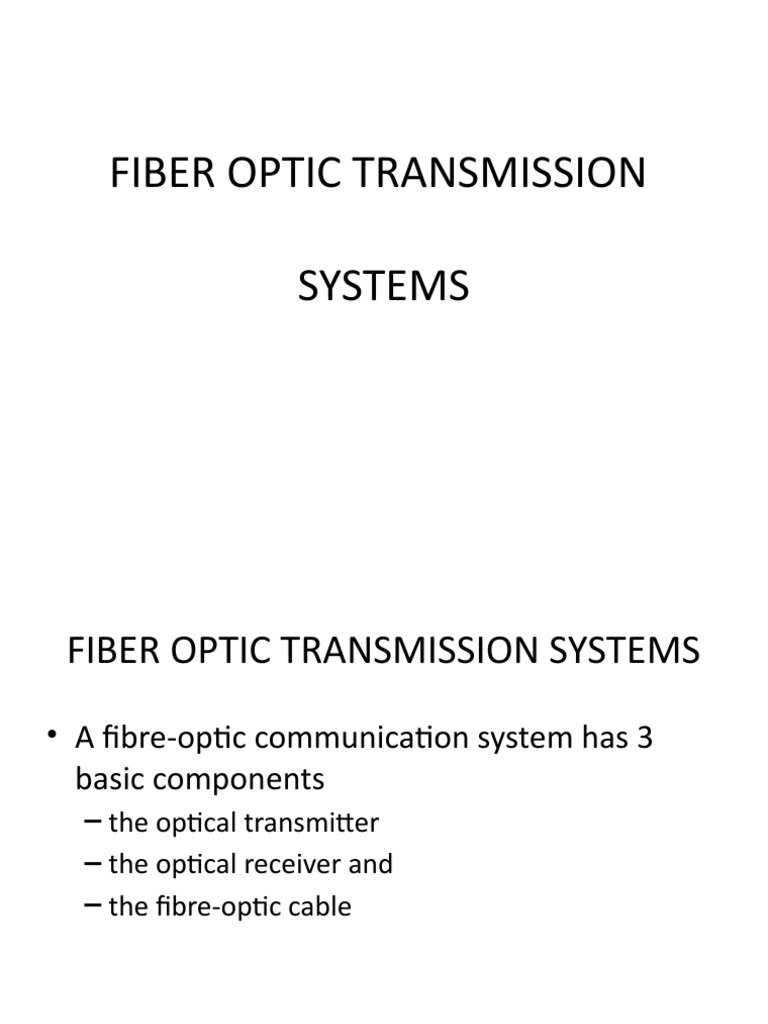Fiber optic transmission technology represents a watershed moment in the realm of telecommunications, enabling unprecedented speeds and bandwidth over considerable distances. Imagine flickering lights racing through fiber cables, transferring vast amounts of data at the speed of light. This is not merely a fanciful notion; it embodies the promise of fiber optics. However, as we advance, what challenges do we face in harnessing this technology? Are we adequately prepared for a world dominated by fiber optics, or is there a greater conundrum lurking on the horizon?
To grasp the principles underpinning fiber optic transmission, it is essential to examine its core components and operation. Fiber optics utilize thin strands of glass or plastic—known as fibers—to carry information in the form of light pulses. Each fiber resembles a hair in diameter but can transmit data over distances exceeding hundreds of miles without significant loss of signal strength. This efficiency arises from the principle of total internal reflection, whereby light is guided through the core of the fiber by reflecting off the inner walls.
The composition of a fiber optic cable is generally bifurcated into three critical components: the core, the cladding, and the protective outer layer. The core, typically fabricated from glass, serves as the medium where the light travels. The cladding, made from a different type of glass or plastic, has a lower refractive index, which is crucial for maintaining total internal reflection. Finally, the protective outer layer safeguards the delicate fibers from physical damage and environmental factors. This meticulous design not only enhances transmission efficiency but also bolsters the durability of the cable.
At the heart of fiber optic technology lies the mechanism of data transmission. Data is encoded into light signals, which are then transmitted along the fiber. This encoding process relies on modulation techniques, converting electrical signals into optical signals. Various modulation formats, such as On-Off Keying (OOK) or advanced techniques like Quadrature Amplitude Modulation (QAM), have been developed to optimize this process, ensuring maximum data fidelity and speed.
One of the most compelling advantages of fiber optic technology is its remarkable bandwidth capacity. Fiber optic cables are capable of supporting multi-gigabit and even terabit transmission speeds, rendering them extraordinarily efficient for transferring large quantities of data. This characteristic has positioned fiber optics as the backbone of modern Internet infrastructure, enabling high-speed connections for businesses and consumers alike. As such, fiber optics are foundational to technologies that require substantial data throughput, including streaming services, online gaming, and cloud computing.
However, while the advantages of fiber optics are substantial, several challenges accompany their implementation. The installation of fiber optic networks necessitates significant infrastructural investment and planning. Laying down fiber optic cables often involves extensive excavation and maintenance, particularly in urban environments where existing infrastructure may complicate installation efforts. The financial implications of deploying a fiber optic network can be daunting, especially for smaller service providers.
Moreover, as fiber optic technology advances, there is an emerging need to consider the sustainability of these systems. The production of fiber optic cables, particularly those made from glass, can be an energy-intensive process. Furthermore, as demand for high-speed connectivity swells, existing supply chains may face strain, raising questions about resource availability and environmental impact. As such, the future of fiber optics must navigate the delicate balance between rapid technological advancement and sustainable practices.
The potential for advancements in fiber optic technology remains vividly promising. Innovations such as Space Division Multiplexing (SDM) and Optical Amplifiers could revolutionize data transmission efficiency, enabling unprecedented data rates and further diminishing signal loss. Moreover, developments in photonic integrated circuits are poised to enhance the performance of fiber optic communication systems, bringing forth a new era of speed and efficiency.
As demand for fiber optic services continues to proliferate, fueled by the proliferation of the Internet of Things (IoT) and smart cities, a salient question looms: Are we prepared to manage the intricacies of a fiber-optic-dominated future? As fiber optics evolve, so too must our strategies for information security, accessibility, and equitable deployment of resources. It is crucial to recognize that merely advancing technology is insufficient. We must also cultivate public understanding and engagement, preparing society to adapt to a rapidly changing landscape.
In conclusion, fiber optic transmission technology stands as a cornerstone of modern telecommunications. It allows for high-speed data transmission while presenting a unique blend of opportunities and challenges. As we look to the future, our focus must shift toward not only the technological advancements but also the intricate socio-economic factors that underpin this transformation. For the world is on the precipice of a transformative technological era; the question remains: will we soar to meet its challenges or fall behind in the shadows of innovation?










